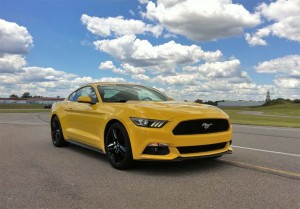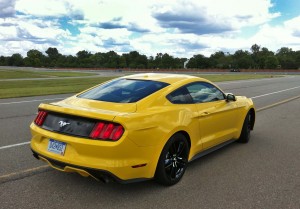
The 2015 Ford Mustang celebrates 50 years of the legendary pony car with improvements in almost every aspect of the car.
“We’re still tweaking,” concedes Tom Barnes, the head of the vehicle dynamics team bringing the new 2015 Ford Mustang to life.
But with the all-new pony car set to roll into showrooms in just a matter of months, most of the work is completed, giving Ford the chance to show off the new Mustang by taking a handful of journalists under the hood – and for some hot laps around its Dearborn, Michigan, proving grounds.
While far from a hands-on driving experience, the event revealed that the 50th anniversary Mustang is likely to live up to the promise laid out by Ford’s global product development chief Raj Nair, who boasted to the media group that “This is the greatest, best-performing Mustang we have ever had.”
From a restyling standpoint, the new pony car isn’t a radical redesign. Though the overall look is more sculpted, more fluidly aerodynamic, with niceties such as new LED running lights, the shape will be immediately familiar to Mustang fans.

A lower overall profile and an independent rear suspension improve the 2015 Mustang's ability to handle twists and turns.
Perhaps the biggest difference, a close inspection reveals, is the fact that the new Mustang is lower and wider – dropping about 35 millimeters, or 1.4 inches, at the hood, and 70 mm at the tail, while picking up 40 mm of width. Credit the fact that Ford came up with an all-new platform – and, for the first time, a new independent rear suspension.
Despite the potential handling benefits, there had been some speculation that the addition of the IRS, among other changes, would carry an unwelcome penalty in terms of weight, one widely repeated report suggesting the 2015 Mustang could gain hundreds of pounds. The good news, Ford revealed, is that the new car has gained surprisingly little mass. The body itself is 25 pounds lighter, helping offset the automatic increase in weight from the switch to an independent rear.
The 2015 Mustang with the new EcoBoost engine and six-speed automatic weighs in at 3,524 pounds, just six pounds more than the 2014 model with a V-6 and automatic. Apples-to-apples, the new V-6 gains 12 pounds in automatic trim, at 3,530 lbs, while the package with the six-speed manual bulked up by 30 pounds. The biggest weight gain? The 5.0-liter GT fastback with its six-speed manual picks up 87 pounds, at 3,705 lbs.
But it also gets a significant performance boost, at 435 horsepower and 400 pound-feet of torque, a gain of 15 and 10, respectively. That means the GT still has the sort of power-to-weight ratio – 8.517 lbs per hp – that even some exotic supercars might envy.
The 3.7-liter V-6 now measures up at 300 horsepower and 280 pound-feet. But for some who don’t want to go all the way up to the GT package, there’s an all-new 2.3-liter inline-four EcoBoost package making 310 horsepower and 320 lb-ft. This is expected to be the engine of choice for many overseas buyers, Ford making a concerted push to build a true global market for the Mustang for the first time.
Boosting performance, especially for the already smoking 5.0-liter V-8 wasn’t easy, the product team stressed, noting that they had to take things down to the smallest details to get there, such as enlarging the valves on the V-8 to get it to breathe as well as the engine in the Boss 302 that was a benchmark.
For the EcoBoost engine, Ford engineers adopted a new twin-scroll turbocharger, a way of boosting low-end torque without sacrificing power at higher RPMs.
And all of the engines were carefully tuned not only with performance in mind but also to deliver the most compelling exhaust notes. In reality, the sound of a performance engine is as much a part of the thrill as its neck-snapping acceleration. The V-6, for example, gets a new pseudo dual exhaust, the exhaust line splitting in two after passing through the resonator midway back.
Both transmissions also underwent significant upgrades to ensure they operate more smoothly and efficiently, the tweaks to the automatic expected to yield about a 1% to 2% increase in fuel economy.
(Mustang feels k-need for airbag speed. For more, Click Here.)
“We set lofty performance targets knowing it would be a global vehicle,” said product czar Nair.
Ford isn’t ready to reveal all those targets, whether 0 to 60 times or fuel economy numbers, though it gave a sense of what’s to come during some hot laps around the Dearborn test track with members of the Mustang team doing the driving.
(Click Here for details on the Dodge Challenger Hellcat ushering in a new muscle car era.)
No burnouts were on the manifest, but these weren’t Sunday drives, either. And the particular track Ford chose was clearly meant to demonstrate that the 2015 Mustang is meant to be more than a straight-line racer, with a procession of tight corners and some aggressive whoop-de-dos that might have seriously upset body and suspension on the old car.
(To see Saleen’s plans for a performance-tuned Tesla Model S, Click Here.)
Both the GT and EcoBoost editions proved delightfully quick and responsive, and able to slam through the corners with a fraction of the body roll we’d have experienced with the old Mustang.
If we discovered any immediate shortfall in the design of the 2015 Ford Mustang, it was the lack of an overhead grab handle for the passenger – a victim of adding new head-mount airbags. Considering the capabilities of the new pony car, we hope Ford engineers consider adding those back soon.


Overhead grab handles…seriously?
Absolutely, Jorge. You’re sitting in the passenger seat being flogged around a track and, even as little body roll as there might be, you are looking for something to hang onto. It’s a norm on most sports cars.
Paul E.